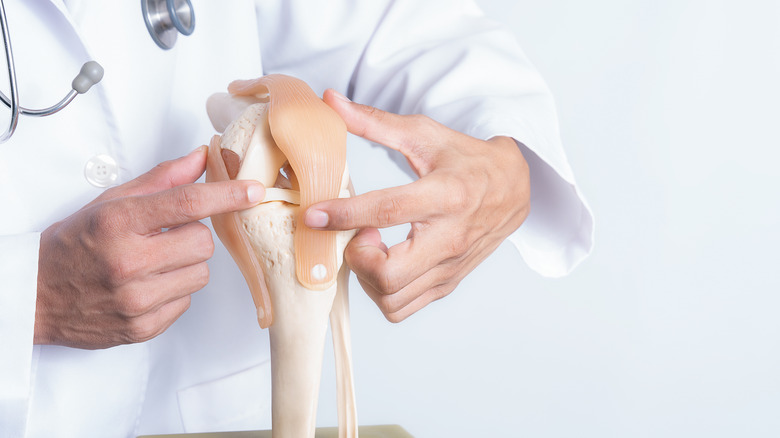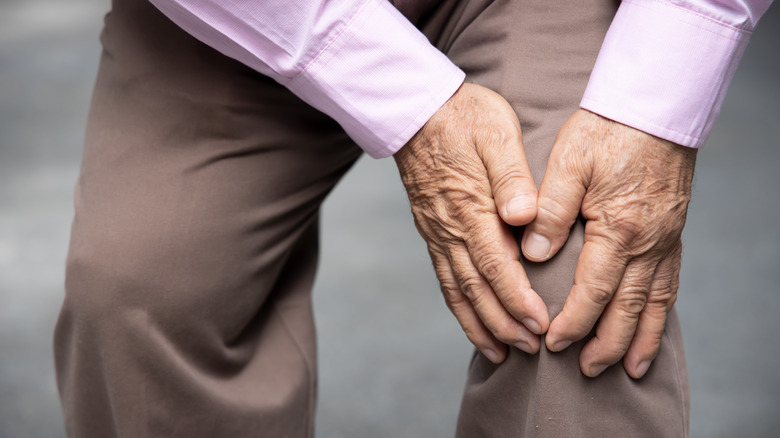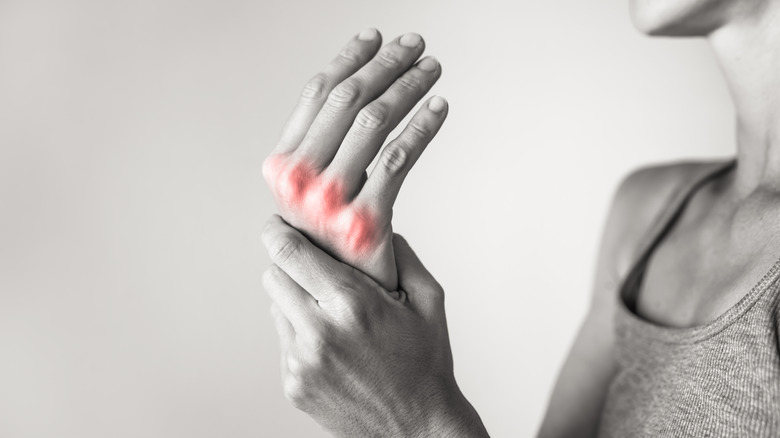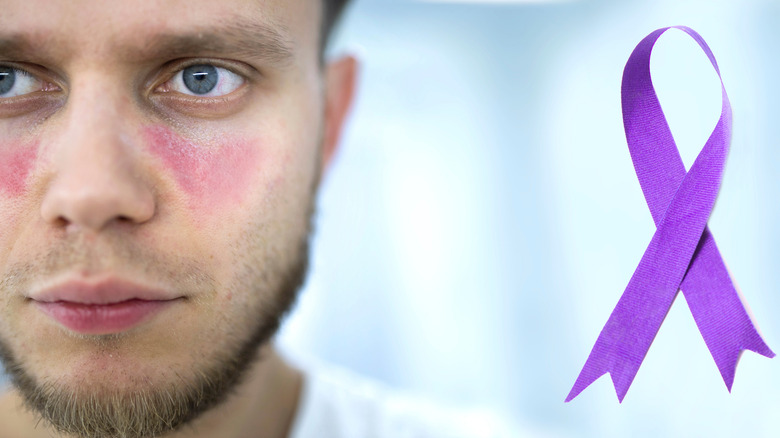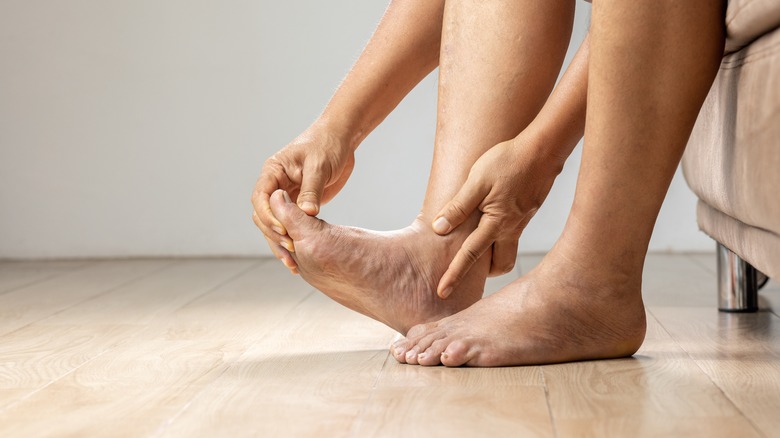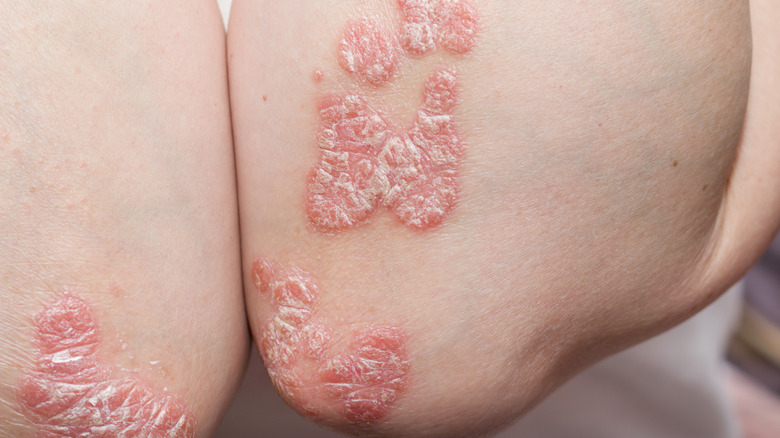The 10 Types Of Arthritis Explained
Arthritis is a very common medical condition that affects almost one in four adults in the United States (via the CDC). Joint pain and stiffness caused by arthritis can impact an individual's ability to live a full and active life, according to the Johns Hopkins Arthritis Center. Based on multiple surveys given to adults suffering from arthritis, there is also a strong link between having the disease and experiencing worse overall physical and mental health.
Arthritis is defined as inflammation or degeneration that affects one or more joints in the body (per MedlinePlus). Some types of arthritis, such as rheumatoid arthritis, can also affect other body systems, according to the CDC. Most forms of arthritis have several treatment options that can help to decrease pain and improve joint function, which are the primary goals when it comes to management.
There are more than 100 different types of arthritis, each with their own unique signs, symptoms, treatments, and potential long-term complications. Here, we'll take a deeper look into 10 of the most common types including osteoarthritis, rheumatoid arthritis, lupus arthritis, gout and pseudogout, infectious (septic) arthritis, reactive arthritis, Charcot joint, ankylosing spondylitis, psoriatic arthritis, and juvenile idiopathic arthritis (via the Arthritis Society Canada, the Cleveland Clinic, and the Arthritis Foundation).
Understanding the joint
According to the University of Rochester, joints are a part of the skeletal system where two or more bones meet. They are made up of several components including cartilage, synovial membrane, synovial fluid, ligaments, tendons, and bursas. The cartilage is a tissue that covers the surfaces of a bone at the joint, and functions to decrease the friction that occurs with movement. The synovial membrane covers the joint and creates a joint capsule, which is then filled with synovial fluid. Ligaments and tendons give structural support, and bursas help to provide an additional cushion to the joint.
With most types of arthritis, there is usually breakdown or damage to the cartilage as well as inflammation of the surrounding synovial membrane (per Occupational Health Nursing). The synovial fluid sometimes contains hints as to what the underlying arthritis may be caused by. This could include the presence of crystals as is seen in gout and pseudogout, or the presence of bacteria as is seen in infectious (septic) arthritis and reactive arthritis, known as Reiter's syndrome.
When all components of the joint are healthy and in working order, there is normal function, pain-free range of motion, stability, and adequate muscle strength. This allows the bending, twisting, flexion, and extension of the arms, legs, hips, back, head, and neck.
Osteoarthritis
Osteoarthritis is the most common form of arthritis, according to StatPearls. It is often referred to as "wear and tear" arthritis as it is related to the overuse of certain joints (per the CDC). Repetitive stress, or even a prior injury may cause damage and breakdown of the joint cartilage between the bones, resulting in the condition.
Osteoarthritis most commonly affects the joints of the hands, hips, and knees. The most common signs and symptoms include pain, stiffness, decreased range of motion, and swelling. Joint pain is typically related to activity and resolves with rest (via StatPearls). The symptoms of osteoarthritis progress and worsen over time.
Osteoarthritis is a clinical diagnosis, meaning that it can be diagnosed based on a thorough history of symptoms and physical examination made by a healthcare provider. This condition is diagnosed if the following are present: joint pain that worsens with activity and improves with rest, age of onset at 45 years or older, morning stiffness that lasts no longer than 30 minutes, joint enlargement, and decreased range of motion. Your healthcare provider can also rely on blood tests, x-rays, ultrasounds of the affected joints, and even examine the synovial fluid to help make a proper diagnosis.
While treatment of osteoarthritis often involves the use of anti-inflammatory and pain medications, there are also other methods to manage the disease. People experiencing more mild symptoms can opt for avoiding activities that trigger pain, not overloading the affected joints, strength exercises, and most importantly weight loss, especially in overweight and obese individuals. For moderate to severe osteoarthritis, your healthcare provider will recommend over-the-counter pain medications such as acetaminophen (Tylenol), ibuprofen (Advil), or intra-articular joint injections.
Rheumatoid arthritis
Similar to osteoarthritis, rheumatoid arthritis is a chronic disease of the joints (via Harvard Health). However, rather than being a "wear and tear" condition, rheumatoid arthritis is both an inflammatory and autoimmune disease where the body's white blood cells attack the cartilage, bones, tendons, and ligaments near joints. While the cause of rheumatoid arthritis is still unknown, several theories suggest it may result from the interaction between an individual's genes and their environment (per StatPearls). Smoking is the strongest environmental risk factor associated with developing the disease.
According to the Mayo Clinic, the most common signs and symptoms of rheumatoid arthritis include tender, warm and swollen joints. Joint stiffness is also common, and is typically worse in the mornings after periods of prolonged inactivity. The early stages of rheumatoid arthritis tend to affect the smaller joints, such as those in the hands and feet. As the condition progresses, other joints in the body may become involved. These include the wrists, knees, ankles, elbows, hips, and shoulders.
As rheumatoid arthritis is an autoimmune disease, roughly 40% of people will also experience signs and symptoms that don't involve the joints. Rheumatoid arthritis may affect the skin, eyes, lungs, heart, kidneys, as well as other body systems.
In addition to a history of symptoms and physical examination, rheumatoid arthritis can be diagnosed with a variety of blood and imaging studies. While there is no cure for rheumatoid arthritis, there are a number of treatment options which can slow progression of the disease. These might include non-steroidal anti-inflammatory drugs (NSAIDs), steroids, disease-modifying anti-rheumatic drugs (DMARDs), and newer biologic agents (Humira, Orencia, Simponi), according to Harvard Health.
Lupus arthritis
Systemic lupus erythematosus (SLE), also known simply as lupus, is another autoimmune condition that causes inflammation to multiple body systems (per the Cleveland Clinic). According to Best Practice & Research Clinical Rheumatology, arthritis is one of the most common symptoms seen in SLE, with an estimated 69-95% of patients diagnosed with this condition experiencing some form of arthritis.
Lupus arthritis most commonly affects the small joints of the hands and feet, and usually appears on both sides of the body (i.e., both hands or both feet will show signs of arthritis). Unlike rheumatoid arthritis, joint swelling is not as common. However, individuals with lupus arthritis will experience joint pain, redness, decreased range of motion, and morning stiffness.
Diagnosis of lupus arthritis can be made with a variety of blood and imaging studies. Treatment involves decreasing inflammation, reducing pain, and improving the overall quality of life of the patient. Somewhat similar to rheumatoid arthritis, lupus arthritis can be treated with a variety of anti-inflammatory medications. These include steroids (prednisone), hydroxychloroquine (Palquenil), azathioprine (Imuran), methotrexate (Rheumatrex), cyclophosphamide (Cytoxan), mycophenolate mofetil (CellCept), belimumab (Benlysta), and rituximab (Rituxan), according to the Cleveland Clinic.
While there is no cure for SLE, proper diagnosis and treatment can help to control symptoms and slow the progression of the disease.
Gout and pseudogout
Gout and pseudogout are two other forms of arthritis, according to WebMD. These diseases are caused by the body's reaction to irritating crystals that deposit in the joints. In the case of gout, a substance called uric acid builds up in the blood. When enough of this substance accumulates, it begins to deposit in the joints. Pseudogout on the other hand develops from a build up of calcium pyrophosphate crystals.
Gout was once known as the "disease of kings," as it was more prevalent in wealthy individuals with diets rich in red meats, alcohol, and sugar (per StatPearls). Gout is more prevalent in men and most commonly develops between the ages of 30 and 50 (via WebMD). Today, gout affects more than 8 million Americans.
Pseudogout is very similar to gout, but is often less painful and does not have an identifiable cause or known risk factors.
Both gout and pseudogout cause pain in the joints. In the case of gout, patients commonly experience attacks of gout, in which there is unexpected and excruciating pain involving the joints of the toes, knees, ankles, elbows, thumbs, or fingers. Pseugogout more commonly affects the joints of the big toe.
Gout and pseudogout are typically diagnosed based on a complete history of symptoms, physical examination, blood tests, joint fluid aspirations, and x-ray (per the Arthritis Foundation). Treatment involves the use of NSAIDs, corticosteroids, and colchicine for acute attacks and flare ups. Gout can also be managed by making dietary changes and through the use of other agents (allopurinol, febuxostat) that lower the levels of uric acid in the body.
Infectious (septic) arthritis
Infectious arthritis, also known as septic arthritis, is a form of arthritis caused by a bacterial, viral, or fungal infection that spreads from another part of the body (per MedlinePlus). These organisms can travel through the bloodstream from another site of infection, such as in a penetrating injury, animal bite, urinary tract infection, skin infection, or trauma (via the Mayo Clinic) Infectious arthritis typically involves one particular joint and is considered an orthopedic emergency, according to StatPearls.
The signs and symptoms of infectious arthritis usually come on suddenly and result in pain, warmth, swelling and reluctance to move the affected joint (pseudoparalysis). Fever is present in 40-60% of cases. Other symptoms may include a fast heart rate (tachycardia), irritability, and a decreased appetite.
Common risk factors for infectious arthritis include existing joint problems (osteoarthritis, rheumatoid arthritis, SLE, gout), having an artificial joint, taking medications used for treatment of rheumatoid arthritis, fragile skin, immunosuppression, and recent joint trauma (per the Mayo Clinic).
Diagnosis is made by laboratory evaluation of the joint fluid, which is commonly analyzed for specific organisms, number of white blood cells, and other potential causes (via StatPearls). Other commonly ordered tests include a complete blood count (CBC), erythrocyte sedimentation rate (ESR), C-reactive protein (CRP), and blood culture. Imaging studies such as x-rays, ultrasound, or magnetic resonance imaging (MRI) can also help in the diagnostic process.
Treatment of infectious arthritis consists of intravenous (IV) antibiotic therapy, drainage of joint fluid, and joint immobilization. Despite appropriate treatment, there is a 7-15% mortality rate associated with "in-hospital septic arthritis" (per Stat Pearls). In those who recover, possible long-term complications may include chronic pain and changes in the lengths of certain extremities (i.e., if the arms or legs are affected).
Reactive arthritis (Reiter's syndrome)
Reactive arthritis is another form of arthritis that is caused by an underlying infection (per Cedars Sinai). It differs from infectious (septic) arthritis in that it is most commonly caused by the bacterium Chlamydia trachomatis. Also known simply as chlamydia, Chlamydia trachomatis is one of the most common sexually transmitted diseases (STDs) in the United States. It is easily spread because it often causes no symptoms (via WebMD).
While reactive arthritis commonly causes symptoms of arthritis (joint pain, warmth, and redness), it can also result in urinary tract symptoms (increased urinary frequency, burning pain with urination, urinary discharge) and eye inflammation (redness, painful eyes, blurred vision). When these symptoms are present, an individual can be diagnosed with Reiter's syndrome. Other signs and symptoms of reactive arthritis may include tendonitis (inflammation or tendons that are attached to bones), bony growths in the heel of the foot (heel spurs), as well as inflammation of the spine (spondylitis) and lower back (sacroiliitis).
Similar to other forms of arthritis, reactive arthritis is commonly diagnosed based on a complete history of symptoms as well as a thorough physical examination. While there are no specific tests for the condition, certain tests can help make a diagnosis. These include blood tests such as measuring the ESR, testing for infections, joint aspiration, analysis of the urine, x-rays of the joints, and even genetic testing.
According to the American Academy of Family Physicians, treatment of reactive arthritis involves the use of strong NSAIDs (indomethacin), antibiotics (doxycycline, clindamycin), and corticosteroid joint injections, all of which are given for a period of up to several months.
Charcot joint
Charcot joint, also referred to as neuropathic osteoarthropathy or Charcot neuroarthropathy, is a rare destructive joint disorder that is initiated by trauma to a joint already affected by another condition called peripheral neuropathy (per StatPearls).
According to the Journal of Clinical & Translational Endocrinology, Charcot joint was first described almost 130 years ago by a French neurologist who saw a unique form of arthritis among his patients suffering from syphilis. While this condition is most common in diabetics with peripheral neuropathy, it can also occur in those with other neurologic conditions such as cerebral palsy, spina bifida, leprosy, syphilis, and excessive alcohol intoxication.
Despite being first described almost 130 years ago, the specific mechanism behind the disease — as well as the diagnosis and treatments — are still under debate. Current diagnostic criteria are complex and involve staging based on both clinical and radiologic findings.
Non-pharmaceutical management of Charcot joint consists of long-term immobilization and surgery. Medical treatment can involve the use of bisphosphonates (drugs that prevent excessive reabsorption of bone), intranasal calcitonin (Miacalcin Nasal), and recombinant parathyroid hormone (rhPTH).
Due to the rarity of the condition, there have been very few clinical trials to study the effectiveness of treatment options. For this reason, there are no formal clinical recommendations for healthcare providers when it comes to treating Charcot joint. Nevertheless, this condition remains a serious complication and requires appropriate and timely diagnosis and treatment.
Ankylosing spondylitis
According to the Cleveland Clinic, ankylosing spondylitis is a form of arthritis that affects the lower back. It is most common among individuals who have a variation of the human leukocyte antigen-B gene (HLA-B). This gene results in the increased production of a protein, called HLA-B27, which predisposes these individuals to developing ankylosing spondylitis. While anyone can develop ankylosing spondylitis, it is most commonly seen in men between the ages of 17 and 45.
Early signs of ankylosing spondylitis include stiffness and pain in the lower back and hips (per the Mayo Clinic). More specifically, the pain and stiffness occur in the joints that connect the base of the spine and the hip bones, as well as the lower vertebrae. While most forms of arthritis worsen over time, symptoms of ankylosing spondylitis may improve, worsen, or even stop at irregular intervals.
According to the Mayo Clinic, diagnosis is made through a complete history of symptoms and physical examination, as well as imaging and lab studies. A healthcare provider may try to reproduce the pain by applying pressure to specific areas of the lower back and legs. X-rays and MRIs may show signs of chronic changes in the joints and bones. Finally, specific lab tests may check for markers of inflammation (ESR, CRP) or for the presence of the HLA-B27 gene.
Treatment of ankylosing spondylitis aims to relieve symptoms and prevent progression of the disease, as it can progress to cause deformities in the lumbar spine and pelvis. NSAIDs are a common first-line treatment option. Other drugs include the tumor necrosis factor (TNF) blockers and interleukin-17 (IL-17) inhibitors such as adalimumab (Humira), infliximab (Remicade), and secukinumab (Cosentyx).
Psoriatic arthritis
Psoriatic arthritis is a form of arthritis that affects individuals who suffer from psoriasis, an immune-mediated condition that causes raised plaques and scales on the skin (per the Mayo Clinic and National Psoriasis Foundation). Most individuals who develop psoriatic arthritis have long standing psoriasis.
The signs and symptoms of psoriatic arthritis are very similar to those of rheumatoid arthritis. However, psoriatic arthritis can also cause swelling of the fingers and toes, foot pain (Achilles tendonitis and plantar fasciitis), pain in the lower back, nail changes (pitting and separation), and complications of the eyes (pain, redness, blurred vision, vision loss).
According to Harvard Health, psoriasis can be diagnosed based on characteristic skin and nail changes. Psoriatic arthritis is diagnosed based on physical examination findings, and occasionally imaging and laboratory studies. During a physical exam, a healthcare provider will examine the joints for signs of pain, redness, and swelling (via the Mayo Clinic). They may also order an x-ray or MRI to help localize the cause of the arthritis. Laboratory tests for psoriatic arthritis may include looking for the presence of rheumatoid factor (RF) antibody and joint fluid analysis.
Similar to the other immunologic forms of arthritis, treatment is based on the use of NSAIDs, DMARDs, biologic agents (Humira, Enbrel, Cosentyx, Remicade), as well as newer oral agents (Otezla).
Juvenile idiopathic arthritis
Juvenile idiopathic arthritis (JIA) is the most common form of arthritis among kids and teenagers (via the Arthritis Foundation). According to StatPearls, JIA makes up a group of inflammatory arthritic conditions affecting children under the age of 16. While the cause of JIA remains unknown, several studies have found that there may be a genetic link.
The most common signs and symptoms of JIA include joint pain, swelling, stiffness, in addition to fever, swollen lymph nodes, and rash (per the Mayo Clinic). Parents may notice that their child limps, especially after naps or first thing in the morning. While joint problems may be most noticeable in the large joints such as the knee, it can sometimes affect more than one joint. JIA is also characterized by flares, where symptoms suddenly become worse and then return to normal.
According to the Mayo Clinic, parents should take their child to see a healthcare provider if they notice new joint pain, swelling or stiffness lasting longer than a week, especially if there is a related rash or fever.
Diagnosis of JIA can be difficult, however a complete history of symptoms, physical examination, blood tests (ESR, CRP, rheumatoid factor antibody), and x-rays can help point toward a diagnosis of JIA. Treatment is similar to most other forms of arthritis. This includes NSAIDs, DMARDs, biologics (Humira, Inflectra, Remicade), and corticosteroids.


